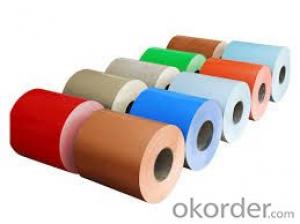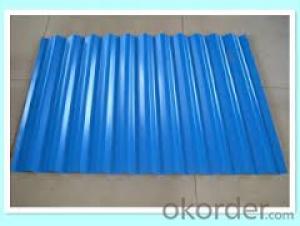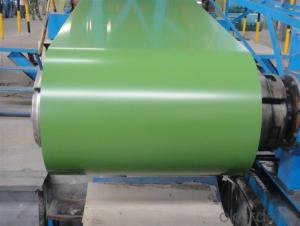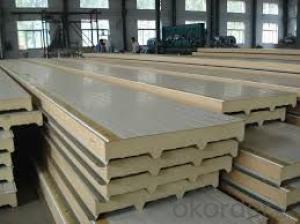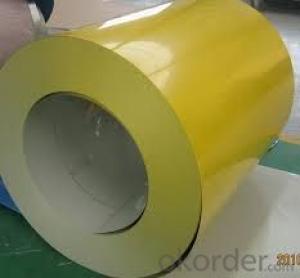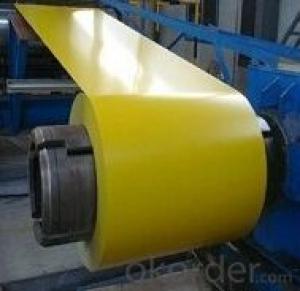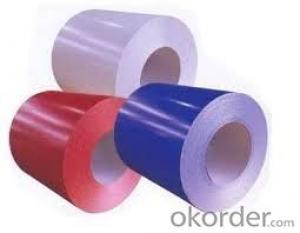Color Coated Steel Coil/PPGI Prepainted galvanized Steel Coil (PPGI/PPGL) /SGCC/Roofing steel
- Loading Port:
- Shanghai
- Payment Terms:
- TT OR LC
- Min Order Qty:
- 50 m.t.
- Supply Capability:
- 10000 m.t./month
OKorder Service Pledge
OKorder Financial Service
You Might Also Like
Quick Details
| Standard: | AISI,ASTM,GB,JIS | Grade: | CGCC, DX51D | Thickness: | 0.25-0.8MM |
| Place of Origin: | Zhejiang China (Mainland) | Brand Name: | CNBM | Type: | Steel Coil |
| Technique: | Cold Rolled | Surface Treatment: | Coated | Application: | Roofing |
| Special Use: | Silicon Steel | Width: | 800-1250MM | Color: | Ral or according to sample |
Packaging & Delivery
| Packaging Detail: | color steel coil STANDARD EXPORT SEAWORTHY PACKING |
| Delivery Detail: | 25 DAYS AFTER DOWN PAYMENT |
Specifications
color steel coil
Prime Quality, Quick Delivery, Competitive Price
Prepainted Galvanized Steel Coil (PPGI/PPGL)
Base material: Hot dipped galvanized steel
Width: available from 800MM to 1250MM
Width Tolerance: within 0.02MM
Thickness: available from 0.18MM to 0.80MM
Thickness Tolerance: within 0.15MM
Performance: Smooth or Matte
Color: according to RAL standard
Lacquer Coating thickness: according to customer needs
Supply capacity: 8,000 Metric Ton per month
Our products has good performance on combining force and anti-erosion. We offer fine quality products and best price for our international customers.
COLOR COATING LINE
A Dual Uncoiler
B Stitcher
C Bridles
D Entry Accumulater
E Degreasing & Chemical Section
F Prime Coater
G Prime Oven
H Prime Water Quench
I Finish Coating
J Finish Back Coater
K Finish Oven
L Finish Water Quench
M Exit Accumulater
N Recoiler
- Q: How are steel coils used in the manufacturing of industrial compressors?
- Steel coils are used in the manufacturing of industrial compressors primarily for the construction of the compressor's casing and frame. The steel coils are shaped, cut, and welded to create the sturdy and durable structure that houses the compressor components. Additionally, the steel coils may also be used in the fabrication of other parts such as motor mounts or brackets, contributing to the overall reliability and stability of the compressor.
- Q: What are the common methods of packaging steel coils for international shipping?
- Various techniques are employed to package steel coils for international shipment in order to guarantee their safety and security during transit. One approach involves the utilization of wooden crates. Steel coils are positioned on wooden pallets and fastened with steel bands or straps. Next, wooden boards or plywood are placed over the coils and firmly attached with nails or screws to create a robust crate. This method ensures exceptional protection against damage and guarantees that the coils remain fixed in place during transportation. Another option is to employ steel frames or skids. Steel coils are positioned on specially designed steel skids or frames that can support the weight and shape of the coils. These coils are then secured to the skids or frames using steel bands or straps. This method offers a high level of stability and protection, making it particularly suitable for larger or heavier coils. In addition to wooden crates and steel frames, steel coils can also be packaged using steel containers or shipping containers. These containers are specifically designed to transport heavy or bulky items and provide a secure and protective environment for the coils. The coils are loaded into the container and secured with steel bands or straps to prevent movement during transit. Regardless of the chosen packaging method, it is crucial to ensure that the steel coils are adequately shielded from moisture, corrosion, and other potential hazards. This may involve the use of moisture-resistant materials such as plastic or wax paper, as well as the application of protective coatings or wraps. In summary, the common methods of packaging steel coils for international shipping include wooden crates, steel frames or skids, and steel containers. The selection of these methods depends on factors such as the size, weight, and specific requirements of the coils, with the ultimate goal of providing maximum protection and security during transit.
- Q: How do steel coils contribute to the marine vessel construction industry?
- Steel coils are a vital component in the marine vessel construction industry as they serve as the primary material for building the hulls and structural components of ships and boats. The high strength and durability of steel make it ideal for withstanding the harsh conditions of the marine environment, including corrosion from saltwater and extreme weather conditions. Steel coils are used to fabricate various ship parts such as hull plates, bulkheads, decks, and frames, ensuring the structural integrity and safety of the vessel. Additionally, steel coils allow for efficient and cost-effective manufacturing processes, enabling the construction of vessels of different sizes and types to meet the diverse needs of the maritime industry.
- Q: How are steel coils used in the manufacturing of railroads?
- Steel coils are used in the manufacturing of railroads as they serve as a primary raw material for producing railway tracks. These coils are processed and cut into appropriate lengths, then shaped into rails through a series of rolling and forging techniques. The resulting rails provide the necessary strength, durability, and stability required to support heavy loads and withstand the wear and tear of train traffic.
- Q: How are steel coils used in the shipbuilding industry?
- Steel coils are used in the shipbuilding industry primarily for the construction of ship hulls, decks, and other structural components. These coils are typically processed and shaped into plates, beams, and other forms to provide strength and stability to the ship's structure. The high tensile strength and durability of steel make it an ideal material for shipbuilding, ensuring the vessel's ability to withstand harsh marine environments and heavy loads.
- Q: an 18k steel and gold, screw style bracelet how much would it be worth?
- If you use a Gold Calculator you can find out how much it is worth.
- Q: What are the main steel coil producing countries?
- The main steel coil producing countries are China, Japan, India, the United States, and Russia.
- Q: What are the different methods of cutting steel coils into sheets?
- There are several methods of cutting steel coils into sheets, including shearing, slitting, and laser cutting. Shearing involves a straight blade that cuts through the coil to create individual sheets. Slitting uses circular knives to cut the coil into narrower strips, which are then further processed into sheets. Laser cutting uses a high-powered laser beam to precisely cut the coil into sheets, providing more flexibility in terms of shapes and sizes.
- Q: What are the different types of steel coil packaging systems?
- There are several different types of steel coil packaging systems, including stretch wrapping machines, coil wrapping machines, steel coil strapping machines, and steel coil wrapping and strapping machines. These systems are designed to securely package steel coils for storage and transportation, providing protection against damage and ensuring safe handling.
- Q: How are steel coils used in the production of metal facades?
- Steel coils are used in the production of metal facades as the primary material. These coils are unwound and then processed through various manufacturing techniques, such as cutting, shaping, and forming, to create the desired facade panels. The steel coils provide strength, durability, and versatility, allowing for the creation of aesthetically pleasing and functional metal facades in various architectural applications.
Send your message to us
Color Coated Steel Coil/PPGI Prepainted galvanized Steel Coil (PPGI/PPGL) /SGCC/Roofing steel
- Loading Port:
- Shanghai
- Payment Terms:
- TT OR LC
- Min Order Qty:
- 50 m.t.
- Supply Capability:
- 10000 m.t./month
OKorder Service Pledge
OKorder Financial Service
Similar products
Hot products
Hot Searches
Related keywords
